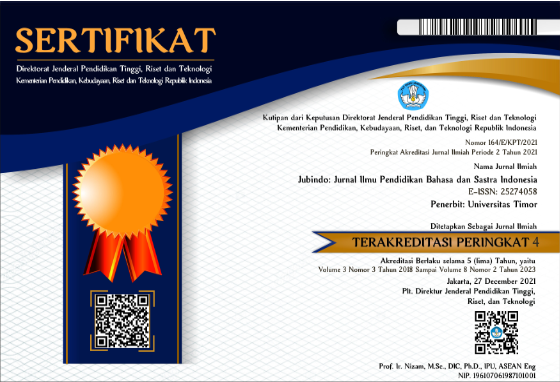KEMAMPUAN MEMBACA ANAK TUNAGRAHITA
(Tinjauan Linguistik Klinis terhadap Siswa Kelas XII SPLB-C YPLB Bandung)
Keywords:
Kemampuan membaca, anak tunagrahita, intervensi klinisAbstract
This study aims to identify and describe the reading ability of students with intellectual disabilities in Grade XII of SPLB-C YPLB Bandung from a clinical linguistics perspective. Through qualitative descriptive research methods, observations were conducted on three students categorized as having mild to moderate intellectual disabilities. The study included observations of their ability to read syllables with consonant-vowel (CV), vowel-consonant (VC), and consonant-vowel-consonant (CVC) patterns, as well as in-depth interviews with teachers. The observations revealed that students with mild intellectual disabilities demonstrated better recognition and reading of syllable patterns compared to students with moderate intellectual disabilities. The main challenges faced were reading complex syllable patterns and blending sounds, which affected their ability to comprehend written instructions. This study recommends intervention based on the unique characteristics of each child, utilizing multisensory teaching approaches, and involving parents in supporting learning at home to improve the reading skills of students with intellectual disabilities.
References
Ainsworth, M. K., Evmenova, A. S., Behrmann, M., & Jerome, M. (2016). Teaching phonics to groups of middle school students with autism, intellectual disabilities and complex communication needs. Research in Developmental Disabilities, 56, 165-176.
Aprianto. (2019). Pendampingan Partisipatori Dalam Meningkatkan Kemandirian Masyarakat Tunagrahita. Jurnal Pendidikan: Teori, Penelitian, dan Pengembangan, 795–802.
American Association on Mental Retardation. (2002). Mentalretardation: definition, classification, and systems of supports.Washington,DC:
Amin, Moh. (1995). Ortopedagogik Anak Tunagrahita.Departemen Pendidikan dan Kebudayaan: Direktorat Jendral Pendidikan Tinggi.
Allor, J. H., Mathes, P. G., Roberts, J. K., Cheatham, J. P., & Al Otaiba, S. (2014). Is scientifically based reading instruction effective for students with below-average IQs? Exceptional Children, 80, 287-306.
Efendi, A. (2006). Pengaruh reading aloud terhadap kemampuan membaca pemahaman anak tunagrahita ringan. Jurnal Pendidikan. Retrieved from https://media.neliti.com
Firdaus, N., & Pradipta, R. (2020). Pelaksanaan pembelajaran siswa tunagrahita di sekolah inklusif. Journal of Educational Research. Retrieved from https://journal2.um.ac.id
Geniofam. (2010). Mengasuh dan Mensukseskan Anak Berkebutuhan Khusus. Jogjakarta: Garailmu.
Hill, D. R. (2016). Phonics based reading interventions for students with intellectual disability: a systematic literature review. Journal of Education and Training Studies, 4, 205-214.
Hoover, W., & Gough, P. (1990). The simple view of reading. Reading and Writing, 2, 127-160.
Kintsch, W., & Van Dijk, T. A. (1978). Toward a model of text comprehension and production. Psychological Review, 85, 363-394.
Perfetti, C. (2007). Reading ability: lexical quality to comprehension. Scientific Studies of Reading, 11, 357- 383.
Pertiwi, R. P. (2014). Meningkatkan kemampuan membaca bagi anak berkebutuhan khusus tunagrahita ringan dengan pendekatan berbasis multimedia untuk sekolah luar biasa. Universitas Pendidikan Indonesia. Retrieved from http://repository.upi.edu/12733/3/S_KOM_1001097_Abstract.pdf
Putra, I. E. (2023). Identifikasi Anak Berkebutuhan Khusus di Sekolah Inklusi: Studi Awal. Jurnal BASICEDU , 202 - 212.
Rahman, R. A. (2021). Pelaksanaan Pembelajaran Membaca Permulaan pada Siswa Tunagrahita Ringan. Jurnal ORTOPEDAGOGIA, 140 - 143.
Roza, Y. E. (2012). Meningkatkan kemampuan membaca kata bagi anak tunagrahita ringan kelas D3/C melalui media kartu suku kata. Jurnal Penelitian Pendidikan Khusus. Retrieved from https://ejournal.unp.ac.id
Shurr, J., & Taber-Doughty, T. (2012). Increasing comprehension for middle school students with moderate intellectual disability on age-appropriate texts. Education and Training in Autism and Developmental Disabilities, 47, 359-372.
Van der Schuit, M., Segers, E., Van Balkom, H., Stoep, J., & Verhoeven, L. (2010). Immersive communication intervention for speaking and non-speaking children with intellectual disabilities. Augmentative and Alternative Communication, 26, 203-218.
http://repository.upi.edu/14962/4/T_LIN_1201214_Chapter1.pdf
https://eprints.unm.ac.id/21962/3/Isi%20Skripsi%20%26%20Lampiran-dikonversi.pdf
https://eprints.uny.ac.id/42689/1/10103244014_DIYAH%20AYU%20DWIJAYANTI.pdf
https://jurnal.penerbitdaarulhuda.my.id/index.php/MAJIM/article/download/403/471
https://vm36.upi.edu/index.php/jassi/article/download/7657/4928
https://ejournal.unesa.ac.id/index.php/jurnal-pendidikan-khusus/article/download/8899/8896
http://conference.um.ac.id/index.php/isolec/article/download/3835/2240
Downloads
Published
How to Cite
Issue
Section
License
Copyright (c) 2024 Jubindo: Jurnal Ilmu Pendidikan Bahasa dan Sastra Indonesia

This work is licensed under a Creative Commons Attribution-ShareAlike 4.0 International License.
Penulis yang mengirimkan naskahnya pada Jubindo telah memahami ketentuan yang berlaku pada jurnal ini. Jika naskah tersebut diterbitkan, hak cipta artikel itu akan diserahkan kepada Jubindo dan Universitas Timor sebagai penerbit jurnal tersebut.
Hak cipta ini meliputi hak eksklusif untuk mereproduksi dan menyiarkan artikel dalam berbagai bentuk media. Reproduksi sebagian atau keseluruhan isi jurnal ini dan segala yang melekat padanya haruslah dengan seizin Jubindo dan Universitas Timor.
Jubindo dan Universitas Timor, Dewan Editor, dan Reviewer berusaha menjamin agar tidak terjadi kesalahan atau penyimpangan dalam penyajian data dan pernyataan yang dikutip pada jurnal. Dalam hal naskah yang termuat berisi penghargaan pada pihak-pihak tertentu sebagai donatur atau sponsor, itu merupakan bagian yang terpisah dari Jubindo dan menjadi kepentingan penulis dengan pihak sponsor.
Semua artikel yang dimuat dalam jurnal ini bersifat Open Access dan bebas dibaca, diunduh, dan disebarluaskan oleh para pembaca selama tidak mengabaikan lisensi yang diacu oleh Jubindo: yaitu http://creativecommons.org/licenses/by-sa/4.0









